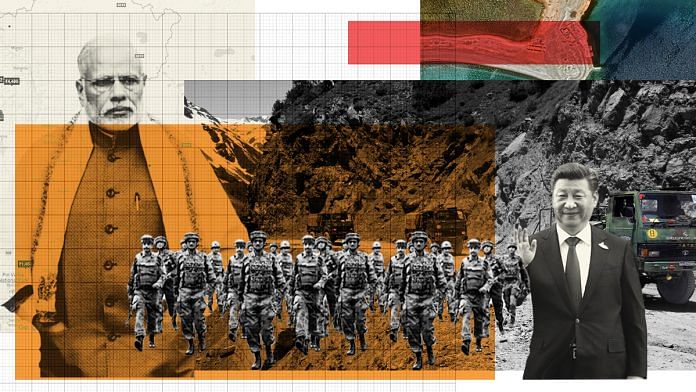New Delhi: India and China are set to carry out a formal verification of the first round of disengagement in Galwan Valley and Hot Spring Area, initiated Monday, by the end of this week before the next round is undertaken, ThePrint has learnt.
While Chinese soldiers have moved out from the Indian territory in Galwan Valley, the process is still on at Patrol Point 15, 17 and 17A in the Hot Spring Area.
“The whole process at PP (patrol point) 15 should be completed by tomorrow. PP 17A might be completed by Thursday. Verification is already on but there will be a formal verification once the first round of disengagement process is completed,” a source told ThePrint.
Once this is done, only then will the next round of disengagement begin, sources said, adding that the verification is being done through visible detection and use of drones.
“The two sides are constantly in touch with each other,” another source said.
This is the second attempt at disengagement between the two countries after border incursions began early May. The first followed a meeting between corps commander-level officers on 6 June, which eventually failed when soldiers violently clashed on 15 June, in which 20 Indian soldiers were killed. The skirmish was a result of the Chinese not holding up their end of the agreement.
The fresh disengagement process saw China move back by about 1.5-2 km in various locations, while the pullback by India was a “little less” since the Army was already in its own territory, sources said.
Also read: Military talks with the Chinese must not wear India down. Plan B should be ready
India won’t resume patrolling upto PP14 immediately
Sources in the defence and security establishment said there was no buffer zone that has been created between the two sides in Galwan Valley, but admitted that normal patrolling activity will not take for some time, as reported by ThePrint Monday.
“One cannot call it a buffer zone. It is more of maintenance of safe distance between the two forces,” a source said.
While both sides moved back to a mutually agreed distance, the Chinese will be closer to the Line of Actual Control (LAC) than India.
The Print had reported that it will be some time before India can resume its normal patrols up to PP 14 in Galwan Valley, and PP 15, 17 and 17A in the Hot Spring area.
There will be no patrolling done by both sides in the area being maintained as a “safe distance” between the two armies.
“Restarting patrolling is a long process. The focus first is to ensure that there is total disengagement that takes place. Restoration of status quo ante will be the final aim,” a source explained.
Also read: Modi’s chest-thumping ministers, and not Congress, are an irritant in dealing with China




The term disengagement may be proper for describing the separation of bad characters wrestling with each other but is inappropriate for describing the state of the armies of two countries engaged in hostile acts towards each other. Here peace will be restored only either by a mutual settlement or by withdrawal of both armies to a certain distance from a mutually agreed no man’s land. Refusing to commit whether there has been any withdrawal or not implies that none of the parties is acting in good faith. This is further so when the so called disengagement caries the caveat that patrolling of even no man’s land is forbidden so that even the no man’s land is actually controlled by the party that prevents the other party from patrolling.
The term Buffer State is used for a State between two States.There is no such thing as a Buffer zone. The term safe distance in these days of aircraft and missiles is a meaningless term. Without beating about the bush and trying to befool the people of India it should be clearly stated that India and China have agreed that a part of the land previously perceived to be India’s will now be perceived as no man’s land.This implies that construction and road building activity will not be undertaken by either side in that area. This should apparently satisfy China as is its main objection was to road and infrastructure building in that sector.